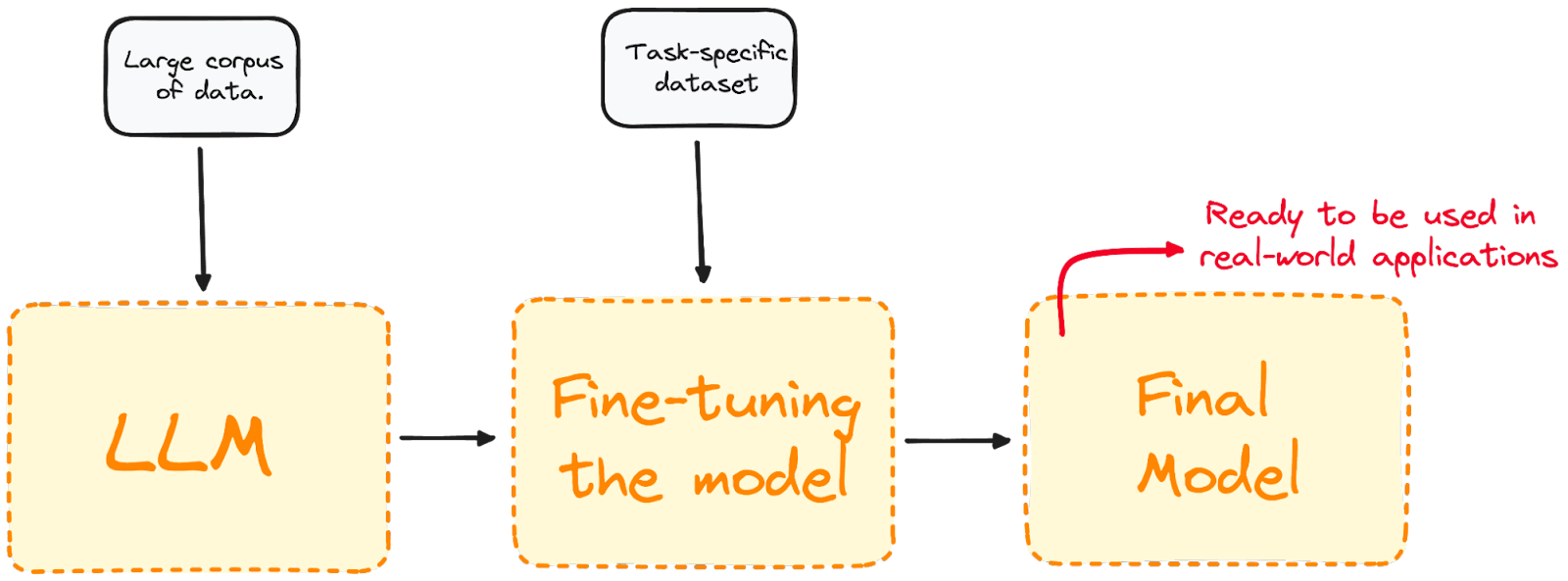Course
Transfer learning is a technique that allows machines to exploit the knowledge gained from a previous task to improve generalization about another. It is a fundamental concept behind the development of models like ChatGPT and Google Gemini, and it aids in many important and useful tasks, like summarizing long documents, drafting complex essays, organizing trips, or even writing poems and songs.
In this guide, we will explore transfer learning in depth. We will discuss its definition, why it’s relevant to deep learning and modern generative AI models, and the challenges and limitations of this technique. We will also suggest resources so you can keep learning. Are you ready? Let’s get started.
What is Transfer Learning in AI?
Transfer learning is a technique where a model developed for a particular task is reused as the starting point for a model on a second task. In other words, you reapply the components of a pre-trained machine learning model to new models intended for something different yet related.
The concept is akin to how humans learn new skills. Let's take an example: Imagine you are an accomplished guitar player and decide to learn the ukulele. Your prior experience with the guitar will accelerate your learning process. This is because many of the skills and knowledge required for playing the guitar—such as finger positions, strumming patterns, understanding the fretboard, music theory, and rhythm—are also applicable to playing the ukulele.
In AI, transfer learning allows you to leverage previous training to solve new, related problems more efficiently, thereby reducing time and computational resources.
Why is Transfer Learning Used?
There are several compelling reasons to adopt transfer learning techniques when developing neural networks, including:
- Training Efficiency: Transfer learning reduces training time by avoiding the need to train models from scratch and allows fine-tuning with smaller datasets.
- Model Performance: Transfer learning enhances model performance by leveraging pre-trained knowledge, reducing overfitting, and enabling faster and more efficient training with limited data.
- Reducing Operational Costs: Transfer learning reduces costs by obviating the need to train models from scratch, where both acquiring the data and using computational resources to train a model can be expensive.
- Enhanced Adaptability and Reusability: Transfer learning is a key technique that allows models to adapt to multiple scenarios and tasks, thereby increasing their potential and usability.
How Transfer Learning Works
Let's explore three concepts that are related to transfer learning: multi-task learning, feature extraction, and fine-tuning.
Multi-task learning
In multi-task learning, a single model is trained to perform several tasks at the same time. The model has a shared set of early layers that process the data in a common way, followed by separate layers for each specific task. This allows the model to learn general features that are useful for all tasks, while also learning task-specific features that are more unique.
This paradigm is widely used in modern LLMs. Check out our Introduction to LLMs Course to learn all the details.
Feature extraction
Feature extraction involves using a pre-trained model to extract meaningful features or representations from data. These features are then used as input for a new model focused on something specific.
Feature-based transfer learning leverages neural networks' unique capabilities to extract features from data. With feature extraction, the model 'figures out', so to speak, what part of the input is important to, for example, classify an image. In practical terms, this means that, when a model is applied to a new task, only the pre-trained first and intermediate layers of the model that contain the more generalizable knowledge are applied.
Fine-tuning
Fine-tuning goes beyond feature extraction and is commonly used when the two tasks are not closely related. It involves taking a pre-trained model and further training it on a domain-specific dataset.
Most LLM models today have a very good global performance but often fail in specific task-oriented problems. Fine-tuning tailors the model to perform better for specific tasks, making it more effective and versatile in real-world applications. If you want to know more about fine-tuning, check out our Introductory Guide to fine-tuning LLMs.
 Visualizing the fine-tuning process. [DataCamp]
Visualizing the fine-tuning process. [DataCamp]
Applications of Transfer Learning
Transfer learning is a common technique for addressing multiple data science tasks, including those in computer vision and natural language processing.
Computer vision
Computer vision is one of the fields where transfer learning has been especially fruitful. Neural networks developed in this field require vast amounts of data to address tasks like object detection and image classification.
In computer vision, the initial layers of neural networks detect edges in images, while the middle layers identify shapes and forms. The final layers are tailored to specific tasks. Transfer learning allows us to create new models by retraining only the final layers, while keeping the weights and biases of the initial and middle layers unchanged. Thanks to transfer learning, it is possible to create new models that only retrain the last layers of the network, while keeping the weights and biases of the first and intermediate layers.
Today, there are a good number of pre-trained, public neural networks in computer visions, for example:
- Visual Geometry Group: VGG is a pre-trained model for image classification that is widely used as a starting point for many image classification tasks.
- You Only Look Once: YOLO is a pre-trained, state-of-the-art model for object detection that excels in its speed and ability to detect a wide range of objects.
Natural language processing
NLP is a branch of AI that focuses on the interaction between computers and humans through natural language. The objective is to program computers to process and analyze large amounts of natural language data, either in text or audio form.
Transfer learning plays a crucial role in developing NLP models. It allows for utilizing pre-trained language models that have been used for general language understanding or translation, and then fine-tuning them for specific NLP problems, such as sentiment analysis or language translation. The applications of NLP are practically endless and include voice assistants and speech recognition.
Transfer learning is behind some of the most popular NLP models, including:
- Bidirectional Encoder Representations from Transformers: BERT, which was created by Google researchers in 2018, is one of the first LLMs based on transformer architecture. It’s a public, pre-trained model that excels in many NLP problems, including language modeling, text classification, and machine translation.
- Generative Pre-Trained Transformer: GPT, which was developed by OpenAI, comprises a series of powerful LLMs at the forefront of the GenAI revolution. GPT models like GPT-3.5 and GPT-4 are the foundation models behind the widely famous ChatGPT. OpenAI also recently launched GPT-4o, the most powerful version yet.
Best Practices and Challenges
At its heart, transfer learning is essentially a design approach to enhancing efficiency. Instead of training models from scratch—which requires a vast amount of resources, money, and time in the case of cutting-edge generative AI models—transfer learning allows models to learn more quickly and effectively in new tasks by leveraging the knowledge acquired in the past.
Transfer learning shines when little data is available to train a model in a second task. By using the knowledge of a pre-trained model, transfer learning can help prevent overfitting and increase overall accuracy. However, transfer learning is not bulletproof and has limitations and potential pitfalls that must be addressed carefully. Some of the most common challenges in transfer learning are:
- Domain Mismatch: Transfer learning is more likely to work well where the source and the target tasks are related. If the new task is very different, the generalizable knowledge transferred may not be enough to perform the new task accurately.
- Data Scarcity: A certain amount of training data is always required. If the training data is extremely limited or the quality of the data is poor, the model is likely to suffer from underfitting.
- Overfitting: Transfer learning is also not immune to overfitting. If the model is fine-tuned too much on a task, it may learn task-specific features that do not generalize well to new data.
- Complexity: Sometimes, the target task is so complex that the fine-tuning process can be challenging, costly, and time-consuming.
Conclusion and Further Resources
Transfer learning is a critical design approach to increasing the efficiency and potential of neural networks. It’s fair to say that the current AI revolution wouldn’t have been possible without the many transfer learning techniques available.
If you want to know more about the specifics of transfer learning, DataCamp is here to help. Check out our dedicated materials on LLMs and neural networks to get started today.

I am a freelance data analyst, collaborating with companies and organisations worldwide in data science projects. I am also a data science instructor with 2+ experience. I regularly write data-science-related articles in English and Spanish, some of which have been published on established websites such as DataCamp, Towards Data Science and Analytics Vidhya As a data scientist with a background in political science and law, my goal is to work at the interplay of public policy, law and technology, leveraging the power of ideas to advance innovative solutions and narratives that can help us address urgent challenges, namely the climate crisis. I consider myself a self-taught person, a constant learner, and a firm supporter of multidisciplinary. It is never too late to learn new things.
Frequently Asked Questions
What is transfer learning?
Transfer learning is a technique widely used in deep learning where a model trained on one task is used as the starting point for a model on a second task. Transfer learning shines specially when the second task is similar to the first task, or when there is limited data available for the second task.
What are the advantages of transfer learning?
Transfer learning is a great optimization technique, that can increase training efficiency and model performance, and drive down operational costs.
What is fine-tuning?
Fine-tuning goes is an implementation of transfer learning is normally used when the two tasks are not closely related. Fine-tuning is the process of taking a pre-trained model and further training it on a domain-specific dataset.
What are the applications of transfer learning?
Transfer learning is a state-of-the-art method for designing neutral networks in domains like computer vision and natural language processing.
